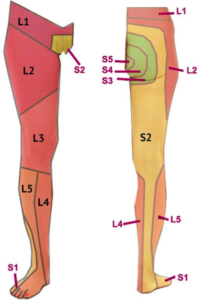What is Lumbar Nerve Root Compression (Radiculopathy)?
Nerve Root Compression, clinically known as Radiculopathy, refers to a compression of nerve roots as they exit the spine. This condition most commonly affects the lumbar (lower back) nerve roots, but it does also occur in the cervical (neck) nerve roots. Pain is largely referred down the leg. Lumbar Nerve Root Compression can also cause neurological symptoms, such as; numbness, tingling, muscle weakness or changes to your spinal reflexes.
Nerve Irritation, pinched nerves, radiculopathy and sciatica are all commonly used to describe Lumbar Nerve Root Compression. You may have been diagnosed with one of these conditions, or may have heard them from a health professional. While it can be confusing to hear so many different names for the same condition, remember that they all refer to the same pain, and your physiotherapist can discuss with you what treatment your specific presentation will require.


| MYOTOME | MUSCLES |
| L1 | NONE |
| L2 | HIP FLEXOR |
| L3 | KNEE EXTENSOR |
| L4 | DORSIFLEXOR |
| L5 | GRET TOE EXTENSION |
| S1 | PLANTER FLEXORS |
What are the symptoms of Lumbar Nerve Root Compression?
- Sustained pain on one side of the body (very rarely bilateral), in the buttock, leg or foot
- Pain that is worsened with sitting
- Pain that is described as burning, shooting or searing
- Weakness or a difficulty moving the leg, ankle or foot
- Numbness, tingling or pins + needles in the leg, ankle or foot
On the diagrams, you can see that specific nerve roots supply the sensory input to different areas of the leg. The specific area that each nerve supplies is called a ‘dermatome’. Each nerve root also provides the innervation to muscles in specific areas, these areas are called myotomes. Depending on which nerve root/s are affected in your injury, the symptoms will generally be distributed along the related dermatomes and myotomes. For example, an L3 nerve root compression may involve numbness around the knee, and weakness to the quadriceps muscles.
What causes Lumbar Nerve Root Compression?
Nerve Root Compression may be caused by any number of conditions affecting your spine including disc herniation, spinal stenosis, osteophyte formation, spondylolisthesis, foraminal stenosis, and other spinal disorders. As the spine, or other tissue impedes on the nerve root’s exit route from the spinal canal, the nerve root becomes compressed. This compression affects the innervations of the area of the body that the nerve root supplies.
How do I know I what condition is causing my Nerve Root Compression?
The best method for diagnosing the specific medical condition is a gentle manual assessment that all Musculoskeletal Physiotherapy Australia Clinicians are highly skilled at performing.

How can you help me with my Nerve Root Compression?
Your Musculoskeletal Physiotherapy Australia Clinician will determine the best course of action with regard to your Nerve Root Compression. This will involve diagnosing the specific cause of your Nerve Root Compression. Usually, treatment will involve decompressing the nerve roots through manual therapy, and strengthening supporting structures, while stretching any tight structures to avoid recurring injury. They will also be able to let you know if you require a medical referral or any additional scanning. Your clinician will then be able to guide you through the rehabilitation process in order to get you back to full strength.
What should I do to avoid aggravating my Lumbar Nerve Root Compression?
- DO NOT smoke.
- Avoid sitting for longer than absolutely necessary.
- Avoid sitting with slumped posture, or bend down to pick things up using a stoop lift.
- REMAIN ACTIVE, but avoid aggravating activities.
- RECEIVE physiotherapy care to get your joints, ligaments and muscles de-loaded and moving freely with no restrictions.
Keep good care of your body and your physiotherapist will continue to monitor your condition. Once your Nerve Root Compression has resolved you will be able to resume your full activities without worrying about future flare-ups.

How long will it take to treat my Lumbar Nerve Root Compression?
After a thorough assessment of your injury and your current condition, your physiotherapist will be able to provide a prognosis, or guidance on how long your injury will take to recover. With the correct management, most cases of Lumbar Nerve Root Compression will see improvement quickly and should see full resolution within three months. Your physiotherapist will be able to guide you and advise if it is going to take more or less time.



